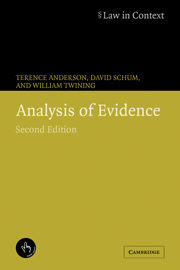Book contents
- Frontmatter
- Contents
- Preface
- Acknowledgments
- Tables of cases and statutes
- Table of legislation and rules
- List of abbreviations
- 1 Evidence and inference: some food for thought
- 2 Fact investigation and the nature of evidence
- 3 Principles of proof
- 4 Methods of analysis
- 5 The chart method
- 6 Outlines, chronologies, and narrative
- 7 Analyzing the decided case: anatomy of a cause célèbre
- 8 Evaluating evidence
- 9 Probabilities, weight, and probative force
- 10 Necessary but dangerous: generalizations and stories in argumentation about facts
- 11 The principles of proof and the law of evidence
- 12 The trial lawyer's standpoint
- Glossary of terms and symbols
- References
- Index
11 - The principles of proof and the law of evidence
Published online by Cambridge University Press: 23 November 2009
- Frontmatter
- Contents
- Preface
- Acknowledgments
- Tables of cases and statutes
- Table of legislation and rules
- List of abbreviations
- 1 Evidence and inference: some food for thought
- 2 Fact investigation and the nature of evidence
- 3 Principles of proof
- 4 Methods of analysis
- 5 The chart method
- 6 Outlines, chronologies, and narrative
- 7 Analyzing the decided case: anatomy of a cause célèbre
- 8 Evaluating evidence
- 9 Probabilities, weight, and probative force
- 10 Necessary but dangerous: generalizations and stories in argumentation about facts
- 11 The principles of proof and the law of evidence
- 12 The trial lawyer's standpoint
- Glossary of terms and symbols
- References
- Index
Summary
Introduction
The purpose of this book is to provide a theoretical and practical foundation for mastering some specific analytical skills relating to the construction and criticism of arguments about disputed questions of fact. It is not a book about the law of evidence, but a central theme has been that the principles of proof and the law of evidence are intimately related. Like Wigmore, we believe that understanding the principles of proof is a valuable, perhaps a necessary, foundation both for understanding the rules and learning how to use them in practice.
At several points this interdependence has been made explicit. Chapters 1 and 2 illustrate the extent to which the two subjects share the same basic concepts: for example, relevance, materiality, weight/probative force, admissibility, inference, credibility, corroboration, prejudicial effect, and so on. In Chapter 3, we saw how nearly all secondary writers on evidence, including all the leading treatise writers, have worked within a framework of shared assumptions, which we called “The Rationalist Tradition.” Those assumptions are common to the principles of proof and the basic principles of the law of evidence in common law countries. We also saw how relevance and weight are governed by “logic and general experience” rather than formal rules and that relevance is the main test of admissibility of evidence. As questions of admissibility are increasingly determined by exercise of judicial discretion and application of balancing tests in the circumstances of a particular case (for example the weighing of prejudicial effect against probative value), so too the logic of proof and the practical operation of rulings on admissibility have increasingly converged.
- Type
- Chapter
- Information
- Analysis of Evidence , pp. 289 - 314Publisher: Cambridge University PressPrint publication year: 2005



